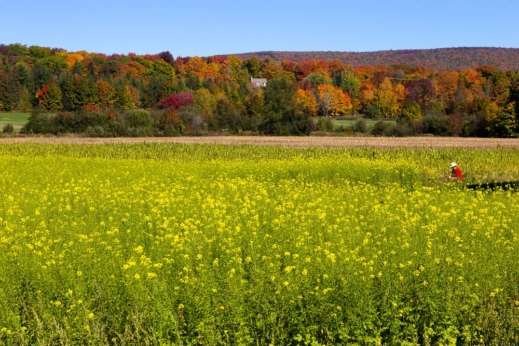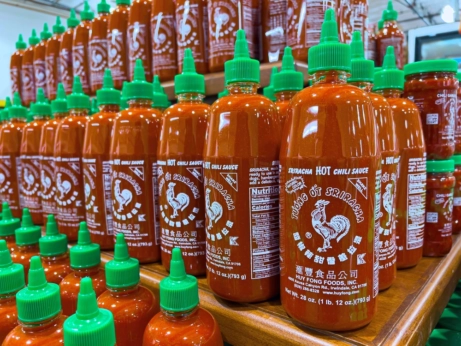From mustard to ketchup, here's what to know about how a warming world will impact the availability of beloved pantry staples.

The hurricanes, floods, droughts and wildfires linked to human-caused rises in global temperatures and changing weather patterns are decimating harvests of essential food crops around the world, driving a crisis in global hunger never before seen in the modern era. According to the World Health Organization, between 691 million and 783 million people faced hunger in 2022, an increase of 122 million people when compared to pre-pandemic levels in 2019.
No person or plant can emerge unscathed, says Dr. Guillermo Murray-Tortarolo, a researcher at Universidad Nacional Autonoma de Mexico. His work focuses on understanding the link between climate change and its impact on food production and human societies. As hotter and wetter conditions become more prevalent, so do the fungi, microbes and insects that thrive in those conditions. They can all increase a plant’s likelihood of disease. As well, changes in temperature make it harder for plants to photosynthesize, so crop yields are dropping.
But while “climate change is affecting absolutely everything,” says Murray-Tortarolo, “some sectors are more impacted than others.”
Dry and semi-arid ecosystems are seeing record biodiversity losses and challenges in the agricultural sector.
“The large increments in precipitation variability and seasonality have reduced the certainty of planting times and expected yields, with some extreme examples occurring the last couple of years, like with the red jalapeño for sriracha and Canadian mustard,” he says. That’s right, folks; climate change is not just taking down staple crops, it’s coming for your most beloved condiments.
Mustard yields are way down
The global mustard market is worth about $6.87 billion, and it is projected to increase by a compound annual growth rate of 5.8 percent through 2029. While mustard seed is native to Europe, World War II disrupted production there, and since then, Canada has become one of the world’s largest producers of yellow, oriental and brown mustard seeds.
Last year, farmers in Canada planted close to 555,000 acres of mustard seed, producing 161,781 tons, primarily in Saskatchewan. But amid challenging weather conditions, yields have plummeted in recent years. In 2021, mustard yields hovered at 431 pounds an acre, down close to 57 percent from the usual 1,000 pounds per acre.
That meant soaring prices and—quelle horreur—a distinct absence of mustard from supermarkets in France. “We lost almost everything during the harvest [of] 2021, but every year for the past 15 years has had extreme challenges,” says Élaine Bélanger, vice president of operations and co-owner of Maison Orphée, a Quebec City-based manufacturer of mustard, olive oils and other specialty products. “And because we are manufacturing organic mustard, we are a niche within a niche market. The costs were going way up in every direction, and even as we were able to source some mustard seeds from abroad, we didn’t want to change our recipe too much.”

A mustard field in Saint-Augustin-de-Desmaures, Quebec, Canada. (Photo: Anne Richard/Shutterstock)
The mustard Maison Orphée creates is a blend of yellow, brown and oriental seeds, and while Bélanger prioritizes sourcing from its network of growers in Canada, in bad years, it’s had to eat the costs of sourcing from Eastern Europe and beyond.
“It’s very difficult for us as manufacturers, and for the growers we work with, to know what to invest in,” says Bélanger. “Because it’s not just an increase in temperature. It’s a change in several ways. If growers invest in a variety that is more adaptable to temperature, what about drought?”
With El Niño conditions this year, Murray-Tortarolo says we should all prepare for challenges.
“This year, an El Niño is predicted, which may bring additional winter rainfall but also extreme conditions,” he says. “While it is too soon to know what to expect in the next planting season, extreme events are expected to be numerous.”
Hot sauce shortages
Hot sauce shortages have also become increasingly the norm.
The maker of the beloved sriracha, Huy Fong Foods, had to issue repeated statements to customers apologizing for the shortage of sauce, blaming poor harvests of chili peppers in California, New Mexico and Mexico for the ongoing dearth on supermarket shelves. (At certain points in the past few years, resellers have been offering the usual $5 bottles for up to $150 to desperate hot-heads.)
As it turns out, where we’re growing these peppers is part of the problem—and climate change is amplifying the issues.
“Peppers first emerged in the rainforest,” says Dr. Danise Coon, a senior research specialist at New Mexico State University’s Agriculture Experiment Station. “And over 6,000 years ago, we domesticated them and eventually moved them to arid climates.”

Huy Fong Food sriracha hot sauce for sale in a Los Angeles supermarket. (Photo: calimedia/Shutterstock)
While we bred and adapted peppers for dry heat, it is now both hotter and drier in the regions in which they are cultivated.
“There are so many more extremes in recent years,” says Coon. “Last year was the hottest on record with 105 degrees or higher for 60 days during the growing season. In New Mexico, there’s a lot of debate going on about drip irrigation, which just adds to the challenges.”
The New Mexico red and green chili production was valued at around $46.2 million in 2022, but farmers also grow cayenne peppers and jalapeños there.
As the weather gets hotter and drier, and widespread irrigation appears less viable, researchers like Coon are working hard at coming up with solutions. “We are working on several projects aimed at combating climate change. We’re trying to breed chilis to produce higher yields under greater stress and drier conditions.”
Her colleague, Dennis Lozada, who specializes in plant genomics and molecular biology at New Mexico State University, says that examining the DNA sequence of individual chilis has been invaluable.
“We are looking at how we can even change things like root morphology to create higher adaptability,” says Lozada.
They are working with an “endless” number of varieties, because there are thousands of wild species, which they can then cross-breed and hybridize. For Coon, it’s not just about saving hot sauce.
“In New Mexico, growing and eating chilis is a cultural thing,” says Coon. “It’s part of our heritage.”
Ketchup’s challenges
Ketchup’s market size is gargantuan. Arguably, so are the challenges it is facing. The ketchup market was valued at around $31.9 billion in 2022, with an expected compound annual growth rate of 4.58 percent through 2028.
Three years of searing temperatures in Australia, Spain and California—three of the world’s top tomato-producing areas—has led to a drop in tomato paste stocks, which not only goes into ketchup bases but is also key for pizza and marinara sauce.
“Our market demands, compounded by climate change, have completely outpaced the ability of staple crops to evolve and adapt to a warmer climate,” says Dr. Amy Concilio, an associate professor of environmental science at St. Edward’s University in Austin, TX.
California produces about 30 percent of the world’s tomatoes and 95 percent of the tomatoes used in canned goods in the US. Harvests were down 10 percent in 2022, according to the United States Department of Agriculture, and that trend is set to continue if things don’t change.
This is where scientists come in. Artificial intelligence apps will be part of the solution, from helping improve weather models to reducing water consumption, says Concilio.
And mega-companies such as Kraft Heinz (the world’s top manufacturer of ketchup) are pouring money into research and drastically reducing their environmental footprint as well. In 2022, its efforts allowed it to reduce water use by 8.7 percent overall and by 16.07 percent in high-risk watershed areas, according to its 2023 ESG Report. The company also sourced 75 percent of its tomatoes sustainably.

The ketchup market is valued at around $31.9 billion. (Photo: Shutterstock)
But perhaps even more importantly, the company is investing in its own breeding program, dubbed HeinzSeed.
“At our core, Kraft Heinz is an agricultural company,” says Patrick Sheridan, vice president of global agriculture and sustainability at Kraft Heinz. The company is the largest purchaser of processing tomatoes in the world and it is serious about maintaining its edge amid a changing climate, says Sheridan.
“We’re aiming to purchase 100 percent sustainably sourced Heinz ketchup tomatoes by 2025,” he says. “One of the most significant challenges we face is water availability.”
Several years of below-average precipitation, coupled with decreased water availability in the regions in which the tomatoes are produced, with further declines anticipated, says Sheridan, has led the company to invest in improving irrigation technology and protocols and next-generation HeinzSeeds that are more heat, drought and disease tolerant.
For the foreseeable future, those who want to buy their condiments ready-made may have to face inflationary prices and shortages.
***
Hungry for a more eco-friendly and dependable alternative that is also kind to your wallet? You’ll never run out of sauces and spices if you grow the ingredients to flavor your foods yourself:
Grow mustard greens
Mustard greens are cooler-climate plants, and they tend to thrive in temperatures between 45 and 75 degrees Fahrenheit. You can grow them in raised beds outside or containers inside. Make sure they have access to six hours of direct sunlight.
Take a plastic planting box with holes in the bottom and fill with prepared planting mix. Scatter mustard seeds over the soil, moisten lightly but don’t soak. Loose soil works best. Cover with cling wrap, and after two to three days, you’ll see seedlings. Remove the wrap, moisten the soil. After five or so days of growing, they’re ready to be harvested, or you can let them grow for up to three weeks. Use an organic vegetable fertilizer to feed these plants, following the directions on the label. Reseed the soil when you’re ready for another crop.
Mustard greens are delicious on their own or sauteed in olive oil with salt and pepper. But if you’re eager to try your hand at making mustard itself, try this easy recipe from HGTV.
Grow serrano peppers
Serrano peppers need six to eight hours of sunlight every day, so make sure you place them near a south-facing window. (Alternatively, use artificial lights designed for gardening.) Also keep in mind that serranos are used to warm temperatures: 70 to 80 degrees Fahrenheit ideally.
Take a plastic planting box with holes in the bottom and fill with prepared planting mix. Sow seeds about ¼ inch deep, and space them one to two feet apart. Loose soil is ideal. You want to keep soil moist but not wet. Use an organic vegetable fertilizer to feed these plants, following the directions on the label. Pepper plants self-pollinate, but you can shake them occasionally to help spur them on.
Serrano chilis will spice up your life in a number of ways, but if you want to turn the chilis into hot sauce, try this basic recipe from the Food Network.
Grow tomatoes
Tomato plants need sun, and you may need some artificial gardening lights as an assist, especially in the winter. Seedlings need 18 to22 hours of light when growing indoors. Once they have color, they need less and can move to a window with plenty of light. Smaller tomatoes grow better inside. Keep in mind that tomatoes also love temperatures of 70 to 80 degrees Fahrenheit.
Give your seedlings a boost by giving your seed-starting trays a little heat (the top of your fridge is a great spot). Once the seedlings are six inches tall, transfer them to a larger plastic planting container with potting mix. Keep the plants moist but not wet. Use an organic vegetable fertilizer to feed these plants, following the directions on the label. Tomato plants self-pollinate, but you can shake them occasionally to help spur them on.
Tomatoes are great on salads, in sandwiches—even solo with salt and olive oil. But we’ve got your back if you want to use yours to make ketchup: This Food Network recipe is a good place to start.